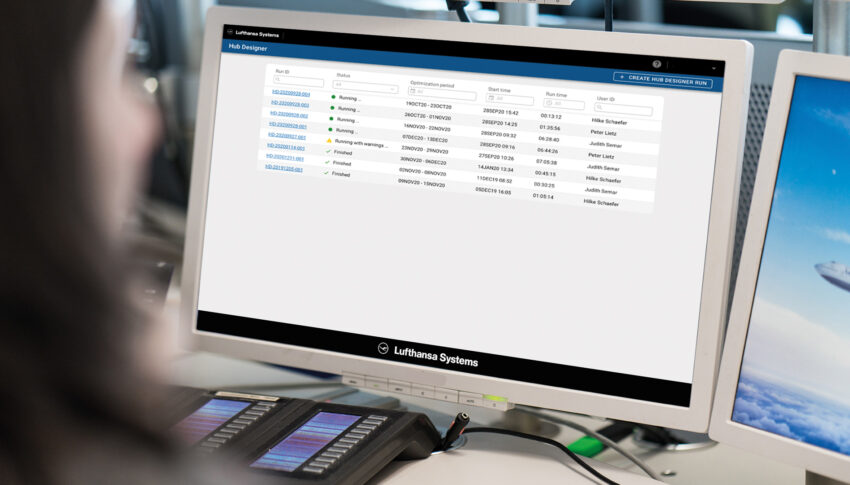Creating, adjusting and optimising airline route networks was hard enough before COVID-19, especially across multiple hubs. With constantly changing demand, supply — and externalities in the form of fluctuating restrictions — the last eighteen months has been even more complex.
Enter a new AI-optimised, cloud-based, full-stack solution from Lufthansa Systems called NetLine/HubDesigner, part of the company’s NetLine family of products, which allows airlines to adjust rapidly to the dynamic conditions in the market, creating bank structures that work profitably even in the COVID context. To understand more, we sat down with Judith Semar, the product owner for schedule optimisation at Lufthansa Systems, for a deep dive into NetLine/HubDesigner, its partner systems, and the technologies behind it.
“NetLine/HubDesigner allows [an airline] to build, and re-build complex networks and schedules automatically and delivers high-quality results,” Semar says. “Even before the pandemic, airlines that managed to adapt quickly to changing market situations had a major advantage by saving costs and realising revenue potential. Now, this adaptability is more important than ever.”
NetLine/HubDesigner is intended to balance supply, demand and operational restrictions, including between hubs, within a scheduling context that will work operationally — according to the restrictions and rules input into the system — that maximises network profitability while providing the most economically efficient amount of supply to meet changing demand in order to create the schedule.
The system starts from a clean-sheet basis, pulling in a large amount of disparate data: provided by the airline, by Lufthansa Systems, or a mixture of the two. The amount of data required, its nature, and its variety of sources were all substantial even before COVID-19. Now, with profitability even more of a priority than ever, folding in the widest variety of data to rightsize the network — of much greater data diversity than before, at a larger scale and much closer to the date of operations — is absolutely vital.
“The optimisation of a single-hub structure is already quite a complex task,” Semar explains. “For airlines pursuing a multi-hub network strategy, the complexity increases exponentially. For all flight offers that are created, one must make sure that internal competition, such as cannibalisation effects between own airlines hubs, is avoided. To put it simply, this means: If all demand is managed via hub A, there is no need to offer a connection via hub B.”
Lufthansa Systems is offering NetLine/HubDesigner either as an as-a-service (aaS) model combined with the existing NetLine/Plan product, with market data provided either by LHS or by the airline, or as a self-service model to draw in parameters from the airline’s own demand models or those provided by others.
The product was developed in collaboration with one of the world’s largest airline groups, in response to the market conditions during the COVID-19 pandemic, building on a substantial platform of Lufthansa Systems work on network management and scheduling.
“By incorporating the knowledge gained from the development of the Schedule optimiser portfolio — Fleet Assigner, Rotation optimiser, Hub optimiser — we were able to quickly build a valuable foundation,” Semar says, noting that this experience “should not be underestimated.”
“Demand and the competitive landscape are subject to dynamic and sweeping change at short notice,” Semar explains. “Even airlines operating based on hub-and-spoke business models have to adjust or completely redesign their networks more frequently, radically, and closer to the day of departure. New solution approaches are needed to create and maintain a profitable bank structure for a hub or multi-hub environment, which takes demand, competition, and operational restrictions into account, enabling airlines to tap market opportunities.”
Part of the novelty of NetLine/HubDesigner as a product is that it integrates three separate optimisers — time, fleet capacity, and rotation — in the commercial and other contexts within which airlines are operating.
The time optimiser “optimises passenger services in terms of times, connections and frequencies,” Semar explains. The second is fleet-based, which “ensures the most profitable fleet utilisation. The optimiser efficiently assigns aircraft to routes while taking revenue and cost structures into account.” Lastly, there’s the rotation optimiser, which “generates feasible aircraft rotations [and] creates a rotation schedule that accounts for operational and commercial demands by considering aspects such as airport slots, maintenance requirements and airport restrictions.”
In terms of inputs, NetLine/HubDesigner starts with market information: market demand data, schedules for the airline and its competitors, and the market model parameters. It also includes cost and revenue information, specifically operating costs and market yields.
Operational and commercial constraints set the context, including slot timings, curfews, aircraft range, aircraft restrictions, minimum ground time, minimum connection time, and other commercial requirements or business rules. This might be, for example, a previously strategically important market that is presently seeing very low demand as the result of externalities like flight bans, but where nonetheless the airline wants to maintain a minimum number of flights.
At the other end of the requirements spectrum, it might be the kind of situation where an airline is limited in the number of national or local slots or rights it holds for operations.
Given the need to review and update the operational context regularly with the changing pandemic travel picture, Lufthansa Systems has focussed on runtime speed, Semar explains. “The architecture and setup of the optimiser are steered towards making it as fast as possible based on state-of-the-art Operation Research optimisation and cloud technology.”
Lufthansa Systems offers its own infrastructure as a service (IaaS) managed cloud service, branded as the Global Aviation Cloud, and Semar confirms that “NetLine/HubDesigner will be provided as part of the Global Aviation cloud and offered as an end-to-end service in the cloud for simple, cost-effective and scalable use,” noting in the context of ongoing infosec and cybersecurity concerns within aviation that “security measures are certified in accordance with multiple industry standards and are regularly reviewed in audits.”
Author: John Walton
Published: 20th July 2021





